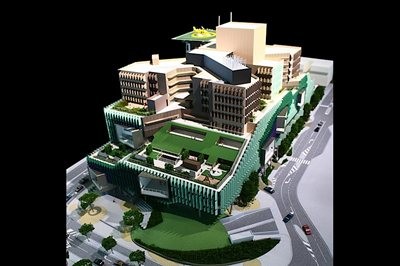Bruce Wolfe, managing director at Conrad Gargett Riddel, specialises in the design of university, health and defence facilities and is currently working on the Queensland Children's Hospital (with Lyons) which is nearing its final height.
Wolfe is a member of the Board for Urban Places, The Society of College and University Planners and has won awards in the field of design, construction and master planning.
Architecture & Design spoke to him about his approach to health design, how design can influence healing and how he dealt with the political aspects of the Queensland Children's Hospital.
What are three key elements to health design?
1. Flexibility and adaptability for replanning. The accelerating rates of change in regimes of care and in technology require buildings, particularly health care facilities, to be able to facilitate those changes with minimum disruption to operational efficiency. These facilities also need to respond to changing demographics and increasing populations, placing critical importance on masterplanning.
2. The importance of the quality of the healing environment. Health, recovery and convalescence are directly linked with levels of stress and anxiety. Natural environments, intuitive way-finding, appropriate noise levels, and access to natural light all contribute to the health of patients and the efficiency of clinical staff.
3. Linking health treatment to healthy lifestyles: Hospitals play a significant role in education both formal and informal. The way these facilities are planned should be extensions of the community and focus not only on the prevention of illness but also on providing inspiration for living.
Of course, the more traditional aspects are also important such as design for the climate, incorporation of the latest technology and efficient circulation etc.
How can design influence healing?
Design is critical in healing, from ease of infection control and ensuring clinical and support staff can operate at the highest level of effectiveness (planning and amenity), to the more qualitative needs for patient focussed care. Patients can experience a greater sense of wellbeing when spaces are designed to feel less institutional through introducing natural light and access to landscape and offer areas for social interaction and reflection.
What type of projects do you most enjoy working on?
From the most complex masterplanning projects to simple buildings, there are always aspects that attract me. It may be finding solutions to meet the simultaneous demands of Queensland’s largest hospital project or designing a small studio for our property in the bush, where simplicity of construction and integration into the natural environment are the key drivers. Naturally, I spend most of my time on the former and such projects generate an energy of their own, which is immensely contagious.
 Above and below, renders of the Queensland Children's Hospital. Images via Conrad Gargett Riddel website. Conrad Gargett Riddel, in association with Lyons, were commissioned for the Architecture, Landscape and Interior Design of the new Queensland Children’s Hospital in 2007.
Above and below, renders of the Queensland Children's Hospital. Images via Conrad Gargett Riddel website. Conrad Gargett Riddel, in association with Lyons, were commissioned for the Architecture, Landscape and Interior Design of the new Queensland Children’s Hospital in 2007.

You work on projects where 'political sensitivities' can have an impact. Can you give an example of where this happened and how you dealt with it?
I have not experienced a more politically exposed project than the Queensland Children’s Hospital. The project was often in the media and also became an election issue. Our role was to design the best children’s hospital for the children of Queensland, their carers and families, and provide a workplace to attract and retain the best staff. Remaining diligent to this outcome and not being deterred by surrounding matters has allowed the design to continue on program and provide a positive focus for clinicians, the design team and the various stakeholders. We have also been sensitive to the different agendas and concerns of interest groups and were conscious of listening to their points of view and how they may have a positive influence on the eventual outcome.
What design trends do you think will emerge in 2013?
There is considerable concern about the vibrancy of the construction industry at present, yet many buildings will continue to be designed and constructed. With this, I am hopeful that there will be a focus on the design quality of the projects that do proceed in this somewhat challenging environment. Also, there will be a greater implementation of modular building systems, with an increase in prefabrication, and the refurbishment of existing high-rise and medium-rise buildings, with an emphasis on sustainability.
What is one project you wish you were currently involved in (another firm's project)?
We undertook the masterplan and the design of the reference project for the Sunshine Coast University Hospital which is being delivered using a public private partnership (PPP) model. Although we are currently still involved as the technical advisor for the State, I would certainly have wished to be doing the detailed design on this very exciting development.
If you weren't an architect, what would you be doing?
I would like to say I’d be playing jazz trumpet, but I was never really talented enough to pursue that as a career. It had spontaneity and creativity alongside a significant amount of discipline that are in some ways similar to being an architect.

